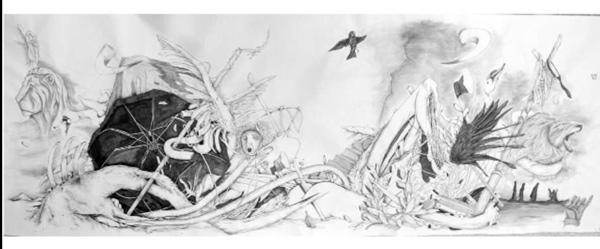Mexican Painter Hector Vargas at Havana’s 2015 Arts Biennale
“Cubans are ahead of us in terms of the anxiety to see.”
by Helson Hernandez

HAVANA TIMES — The public’s expectations about foreign artists soon to arrive on the island to participate in this year’s Havana Arts Biennale (May 22 – June 22) with interesting pieces can already be felt in the city. Today we visit with Mexican artest Hector Vargas.
HT: Why come to Cuba?
Hector Vargas: I hope to get to know the island up close. I also admire the achievements of the revolution, the rigor of contemporary Cuban art, Cuban women and my friend, curator Luis Ramaggio, in that order.
HT: There’s a history of art in your family in Mexico.
HV: Well, yes. I’m the nephew of Mexico’s most legendary caricaturist, Gabriel Vargas. Generally speaking, my family has always had links to art. One of my great grandmothers was an aristocrat who supported Porfirio Díaz, a Toltect descendant through and through, and there are plenty of interesting anecdotes there.
HT: What creative concerns define your work?
HV: I believe the impact of the image, often related to or read as violence, is what governs my work. Before all else, I am interested in speaking about the possibilities of form, and the power to manipulate it that the artist has.
HT: Your first exhibition in Havana was highly innovative.
HV: The positive feedback was incredible! I think this has to do with the fact the Cuban people are highly educated, and they were able to grasp the conceptual intention and encrypted information in the piece. I also believe they were very pleased to see some of the ideas the public suggested to me end up in the canvas. Part of the work consisted in me adding elements on a daily basis during the time of the exhibition.
HT: What will you participate at this year’s Biennale with?
HV: I am working in a community project curated by Vanessa Fernandez Guasch. I’ll be working at the Rafael Trejo boxing gymnasium from June 1 to 5, giving the community, Biennale visitors, locals, sportspeople and the curious a boxing and drawing workshop. We’ll box and draw later. The project is titled El Tigre de Malfica (“The Malfica Tiger”).

HT: What do you want to leave behind through your work?
HV: I am not ashamed to say I am a firm believer in virtuosismo and the artist’s skills, I’d like to hear people saying “my, that bastard draws well!” Of course, there’s more than that – my greatest concern is exploring the possibilities of form and, this way, opening a window in the mind of the spectator, to stimulate their imagination. I would like for my work to have an impact on those that see it, to act like a train careering towards them, who are to survive to tell about it.
HT: Are there any parallels between Mexico and Cuba for you as an artist?
HV: That’s a very good and difficult question. The two countries harbor great graphic talents, tremendous historical burdens and conceptual prowess. Applied to the arts, these yield phenomenal results. They are also well positioned in the market, for I believe any contemporary artist from any of these two countries can become “established” and get exhibited abroad. The great difference between the two is the public. Cuban art spectators look at a piece three times, that is to say, Cubans are ahead of us in terms of the anxiety to see, the ability to understand and process what is being seen. The Cuban public is ahead of ours. That’s the way it is.

HT: Do you have any important projects for the remainder of the year?
HV: To more extensively develop a series of works that connects art to contact sports, pieces I recently inaugurated in Cuba as part of the Kid Chocolate boxing venue project. These can be seen right now in the patio of the Luz y Oficios gallery in Old Havana. I also have a tentative painting and drawing project with Cuban artists that will be exhibited in Norway in the Fall, and the series Todos los chaparros nos sentimos napoleones (“All of Us Shorties Feel like Napoleon”), a series that may be exhibited in Switzerland next year. It’s a very personal series.
Click on the thumbnails below to view all the photos in this gallery. On your PC or laptop, you can use the directional arrows on the keyboard to move within the gallery. On cell phones use the keys on the screen.









